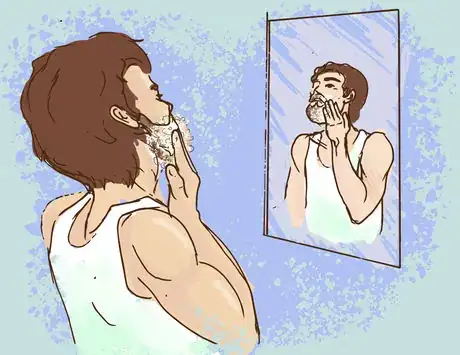This article was co-authored by Kate Holcomb, MD. Dr. Kate Zibilich Holcomb is a Board Certified Dermatologist and the Founder of Pure Dermatology. She has over 15 years of experience in the field and specializes in cosmetic dermatology. Dr. Holcomb earned an MS in Public Health and Parasitology from The Tulane University School of Public Health and Tropical Medicine and an MD from Tulane University School of Medicine. She also completed her residency in dermatology as Chief Resident at Saint Luke’s-Roosevelt Hospital Mount Sinai. Dr. Holcomb is a member of the American Academy of Dermatology, American Society of Dermatologic Surgeons, American Acne and Rosacea Society, Skin of Color Society, North American Contact Dermatitis Society, Louisiana Dermatological Society, and Women’s Dermatologic Society.
This article has been viewed 20,257 times.
Preparing your skin for shaving is essential to achieving a close, clean shave while avoiding razor burns, bumps, redness, dryness or itchiness. Men with sensitive skin are more vulnerable to such side-effects, but dermatologists and barbers have found efficient ways of preventing them. Men’s skin needs to be taken care of daily, not just before shaving. No matter how sensitive your skin is, the correct preparation of your skin ensures good shaving results.
Steps
Doing a Daily Skin Care Routine
-
1Cleanse your face each morning and evening with skin care products that match your skin type.
- Learn about your skin type. Your skin may be normal (oil free and no acne), oily (skin has a natural shine and acne occurs frequently), dry/sensitive (gives you troubles when shaving, it irritates often), mixed (oily forehead and nose, dry cheeks and mandible), and aging (presents age spots).
- Choose a cleansing product dedicated to your skin type (they are labeled accordingly).
- Wash your face every morning with warm water to open up the pores.
- Apply the facial cleanser to remove impurities and dead skin cells and gently rub your face in circles.
- Rinse with cool water and pat dry your face.
- Repeat the process every night you go to bed.
-
2Exfoliate (scrub) your face skin 1-3 times per week. Do this after cleansing in the morning. Exfoliating removes dead skin cells and other impurities. This process helps new, healthier skin cells reveal themselves, improving your complexion.
- Wet your face with warm water.
- Gently rub in circles your face with the scrubbing product.
- Focus on your forehead, nose, mandible and neck as these are the areas where dead skin cells and impurities build up the most.
- Rinse with cool water and pat your skin dry.
Advertisement -
3Hydrate your face each morning and night. To do this, apply a face moisturizer dedicated to your skin type. This helps your skin to become firmer, preventing water loss and making sensitive / dry skin easier to shave.
- Apply the moisturizer in the morning over your entire face after you cleansed your face and patted it dry.
- Gently rub the product until it penetrates the skin.
- Focus on the forehead and eyes’ areas.
- Repeat the process every night.
-
4Protect your skin during the day with the help of a sunscreen product. This will help prevent skin issues, blemishes, skin dryness and the effects of aging. Use sunscreen (at least SPF 15) each day you spend more than 30 minutes in full sun.
- Gently rub the sunscreen on all exposed parts of your face making sure the product penetrates your skin and doesn’t make your face look oily.
- Repeat the process every 2 hours if you spend a lot of time in full sun. Wash the sunscreen off once you come inside.
- Daily sun protection is essential to get spotless skin.
- You may spend a lot of money on skincare, lasers, and beauty treatments, but if you do not protect yourself from the sun, you are wasting money.
- Sun protection should be every day because you get little bits when walking to your classes, driving in the car, sitting in an office or classroom with windows, and going out to pick up the newspaper. That adds up over time and can lead to skin discoloration and wrinkles.
-
5Use eye cream to remove dark circles and bags from under your eyes, if desired. Choose a man’s eye cream based on caffeine as it stimulates the blood flow, reducing bags and dark circles. Gently rub the cream around and under your eyes in circles in a circular movement starting from the temple towards the base of your nose.
-
6Prevent skin damage by keeping a daily hygiene routine.
- Keep your hands clean during the day by washing them and drying them with a fresh towel to avoid transferring germs or dust to your face.
- Use a sanitizer gel for your hands when washing isn’t possible to avoid carrying germs and bacteria from your hands to your face.
- Wash your face frequently during hot days to prevent perspiration clogging your pores, if needed.
- Avoid touching your face with your hands during the day.
Doing a Pre-Shaving Routine
-
1Take a hot shower and make sure your skin is ready for the shave:
- Soak your face in warm water to open-up your pores.
- Cleanse your face with a soap-free product.
- Towel-dry your hair, neck, shoulders, and body after you get out of the shower.
- Keep your face wet.
- Wait approximately ten minutes before you start shaving.
-
2Trim a significantly grown out beard before shaving. Using a razor on a fully-grown beard can be painful and ineffective. It is better to use electric clippers and scissors or a manscaping tool to trim down the beard.
-
3Cleanse and moisturize your face before shaving. Facial cleansers work best because they help soften the protein in the hair.[1]
- Rinse your face with a pre-shave soap and warm water.
- Moisturize your face with a product formulated for sensitive skin.
- Use aloe vera, almond oil, or emu oil to moisturize and prepare for a clean, safe shave.
Using the Right Products
-
1Get a good razor. When looking for a good shaver for manscaping, you should consider a few factors: your skin's sensitivity, the coarseness of your beard, differences between various types of razors.
- Avoid disposable razors.
- Use a razor with built-in moisturizing strip.
- Change your blades after 4-5 uses if you have regular skin & after 2-3 uses if you have sensitive skin.
- Rinse the blade under hot water before you start to shave.
-
2Use specialized electric razors and products if you have sensitive skin that is prone to razor bumps, redness, and other skin conditions.
- Use a pre-shave product before using the electrical razor on your sensitive skin.
- Use a special designed electric razor (dedicated for men with sensitive skin and coarse beards).
- Make sure the electric razor doesn't cut too closely to the skin.
- Soften acne-affected skin before the shave.
-
3Invest in a professional shaving brush. A high-quality shaving brush will help you raise the hair for a closer cut. Furthermore, the shaving brush allows the creation of rich, creamy lather & improves exfoliation, thus reducing the occurrence of razor bumps and blemishes. When buying a shaving brush choose one whose bristles show a good balance between stiffness and softness. Experts say you should choose a brush made of badger's hair.
-
4Invest in professional shaving products. There are plenty of gels, creams or foams on the market designed to keep the stubble soft and the skin moisturized.
- Use a transparent shaving gel with low-forming properties to better see some portions of your skin (either affected by acne or blemishes, burns or razor bumps).
- Use a shaving foam designed for sensitive skin or one enhanced with skin-soothing natural ingredients such as aloe vera. Shaving foam is recommended to men with oily skin.
- Use a shaving cream if you if you have dry skin or stubborn, tough stubble. For sensitive skin use shaving cream formulated with glycerine for skin moisture and softening.
- Use shaving soap which is formulated especially for sensitive skin.
- Use a shaving cream containing glycolic acid or salicylic acid if you suffer frequently from razor bumps as it contains exfoliating agents that unplug pores.
- Use hypoallergenic shaving products without perfume to avoid further irritations on your skin.
Warnings
- Don’t shave against the grain (in the opposite direction where the hair is growing). This may lead to razor cuts, razor bumps caused by ingrown hair, inflammation, irritation and even skin infections.⧼thumbs_response⧽
- Avoid using alcohol-based aftershave lotion to avoid further skin irritation on exposed skin.⧼thumbs_response⧽
- Don’t over shave, especially if you have dry / sensitive skin.⧼thumbs_response⧽







-Step-14.webp)








-Step-13.webp)



-Step-14.webp)






































